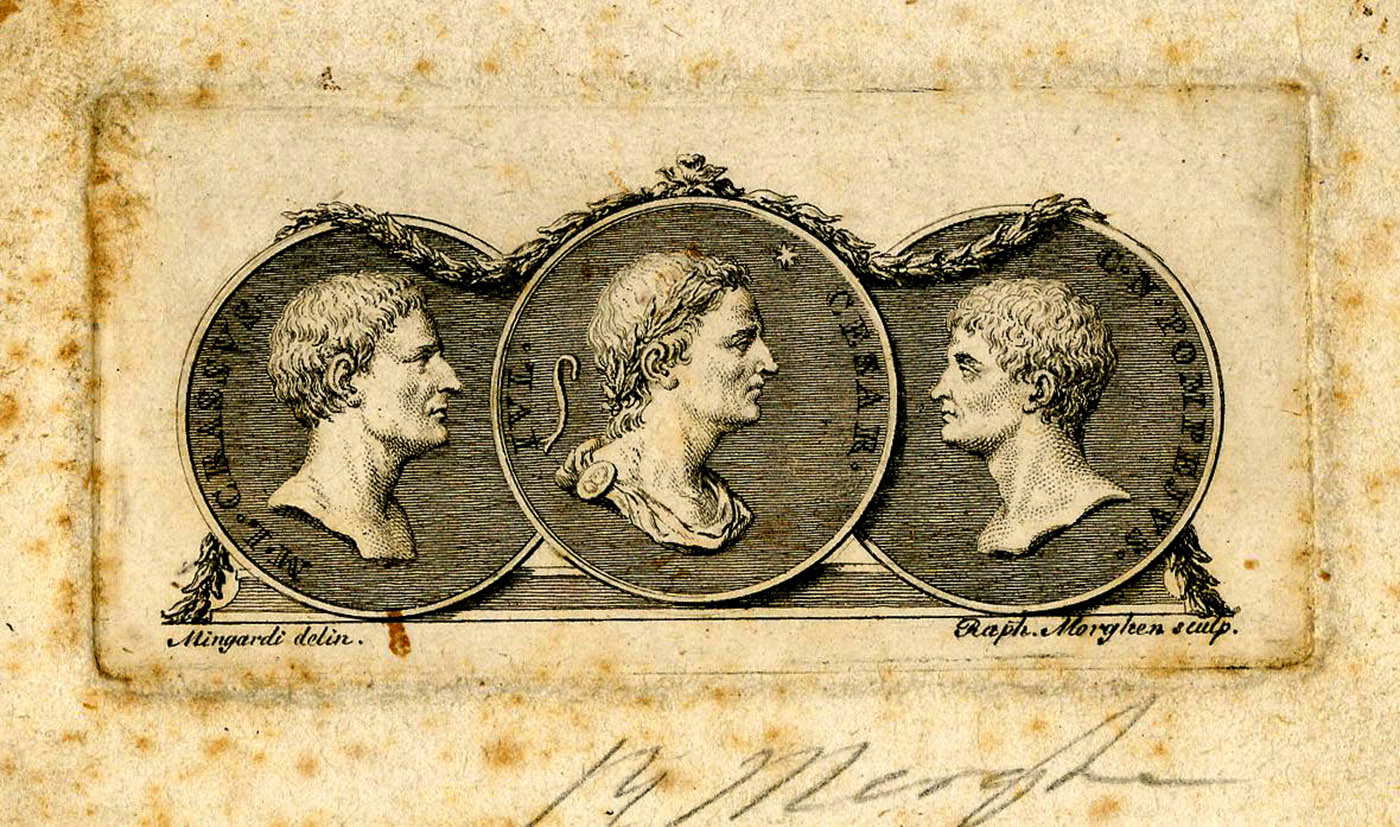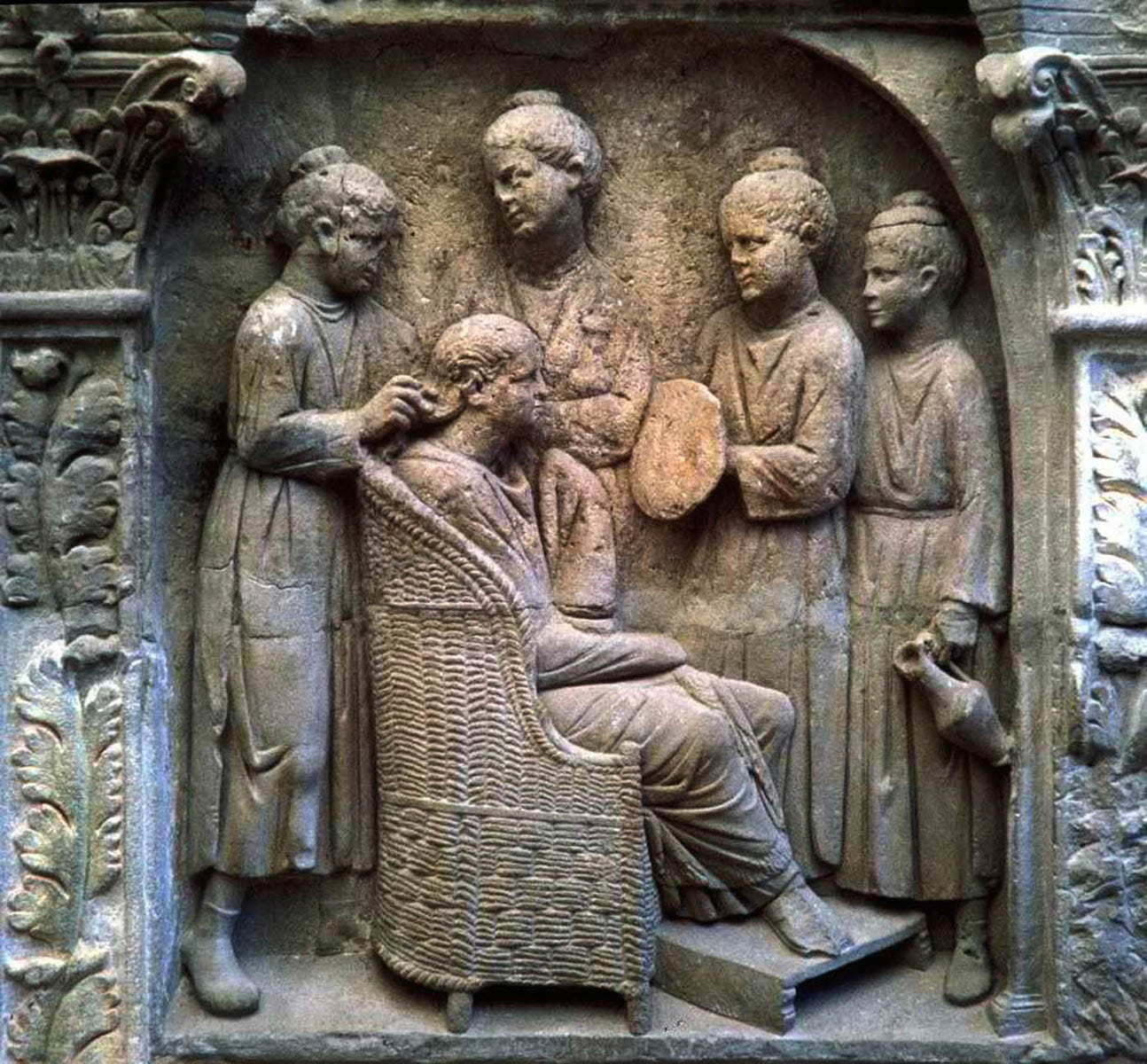How Would You Know Someone Is a Slave in Ancient Rome

Roman social club was structured according to class and wealth. Its hierarchical system saw the senatorial, aristocratic class at the top of the social pyramid. In the centre were the equestrians, the plebeians, and the freedmen, in that order. Those with the everyman social status were the slaves.
Many Roman slaves lived lives of unimaginable cruelty. Subsequently all, Roman law designated slaves as property, not people. Merely slavery in aboriginal Rome underpinned much of lodge's success, and the freeborn citizens of Rome were really heavily dependent on slaves for their world to operate finer.

Vast numbers of slaves were traded throughout the empire, from United kingdom of great britain and northern ireland in the North to Syria in the East. At the outset of the Imperial era, information technology is believed that the ratio of slaves to freeborn people in the urban center of Rome was iii:one. Slave ownership was mutual for those at the acme of club. Plutarch tells usa that the Republican consul, Marcus Licinius Crassus (pictured in a higher place left), owned so many slaves that he had 500 just for acquiring and rebuilding property. Simply it was also not uncommon for plebeians, also every bit ex-slaves, to own a few slaves as well. Slave ownership was a sign of status and wealth which nigh everyone in ancient Rome aspired to.
Evidence for Slavery in Ancient Rome

Roman literature, epigraphical sources, and archaeological finds all provide united states with information about slavery in aboriginal Rome. The letters of Pliny the Younger in particular provide excellent source material on slavery, but there are also obvious limitations to written work produced by elite members of Roman gild. Many, like Pliny, were prone to idealization. Sadly, there is no surviving literature written from the viewpoint of someone actually living the life of a Roman slave.
Are y'all enjoying this article?
Sign up to our Free Weekly Newsletter
Please check your inbox to activate your subscription
Cheers!
Epitaph inscriptions, as we shall see, provide some first-class evidence for the relationships between slaves, ex-slaves, and former masters. Archaeological excavations of the domains of slaves are also very informative. For example, the remains of amphitheaters — the arenas where gladiator slaves and prisoners of war fought — stretch from ancient United kingdom of great britain and northern ireland to Turkey. They serve as a stark reminder of how extensive enforced servitude in the Roman Empire really was.
The Life of a Slave in Aboriginal Rome

In that location were a number of routes into slavery in ancient Rome. 1 of the about common was existence a prisoner of war. The expansion of the Roman Empire from the 2nd century BCE to the 2nd century CE saw many thousands of conquered people forced into servitude.
Some people were sold into slavery. This could be for a number of reasons. Piracy was mutual across the ancient Mediterranean and across. Those captured by pirates were and so sold on like plunder. People who could not pay their debts could even cease up selling themselves into slavery in lieu of payment.
Finally, there were those who were unfortunate enough to be born into slavery. Slave mothers were forced to mitt their children over to their owners soon afterward birth. It was also non uncommon for slave owners to encourage relations between slaves in social club to increase their numbers.

There were many dissimilar types of slaves and they could exist found in every walk of life in ancient Rome. Domestic slaves were perhaps the near mutual. Some were educated or highly skilled and therefore much sought after. Tutors for children, specialist cooks, and even hairdressers could control loftier prices.
The success of urban life depended on an army of slaves. Many worked in civic positions in public libraries and baths and also in government administration jobs, often alongside freeborn plebeians. At the other stop of the spectrum were prostitutes who worked under the watchful eye of violent brothel-keepers.
Many slaves were subjected to lives of manual labor. Some helped to run the rural estates of wealthy landowners, while others endured the horrific world of the mines, often digging for precious gold and silver. Here the incredibly harsh conditions meant that life expectancy could be as low equally a few months.
Roman Slaves and Their Masters

Slavery in ancient Rome was subject to various laws, by and large drawn up in favor of masters, rather than slaves. Slave owners had legal dominium over their slaves, which essentially amounted to the power of life and decease. Some slaves tried to resist servitude and ran away or attacked their masters. The punishments for those who were defenseless were very harsh. If a slave attacked or murdered a chief and so non only the perpetrator but the entire household of slaves could be executed.
It was, arguably, in a master's interest to treat his slaves adequately and nearly probably constitute that this resulted in a more productive workforce. This is not to say that Roman slaves led happy lives but benefits were sometimes granted, such as a small allowance (peculium). Pliny tells us that he even permitted informal marriage pacts and the making of wills.

Some slaves developed close relationships with their masters built on mutual respect, including, for example, the famous orator and politician, Cicero, and his personal secretary, Tiro. The following extract is taken from a letter of the alphabet sent past Cicero'southward brother to Cicero on hearing that Tiro was to be prepare free. Information technology highlights the genuine amore held for Tiro throughout the family.
'I am truly thankful for what you have done with regard to Tiro, in judging his former status to exist below what he deserved and preferring us to accept him as a friend rather than a slave.'
(Cicero, Letters to Friends sixteen:half dozen)
Gladiators — the Celebrity Slaves

Due to their position at the centre of public entertainment and adulation, information technology is perhaps easy to forget that about gladiators were also slaves. Prisoners of war and convicted criminals were often forced to get gladiators if they had the physical requirements. These men went on to live and train at a combat schoolhouse (ludus) under a specialized trainer, often an ex-gladiator himself (lanista).
Many fought to the death in amphitheaters under the gaze of huge crowds — although information technology is a myth that a gladiator died in each and every fight. Gladiators were very expensive commodities and their popularity with the crowd often meant that they were spared expiry.

Information technology is perhaps a footstep too far to describe gladiators as the glamorous representatives of slavery in aboriginal Rome. But some became very well-known and lived their lives in the spotlight. Ancient sources tell us that some women were very fond of gladiators. Pocket-sized jars of sand soaked in their sweat were even sold outside amphitheaters equally an aphrodisiac.
A gladiator who was specially successful could sometimes earn his freedom, at the discretion of the lanista. If granted, he would exist awarded a wooden sword (a rudis) equally a symbol of his freedom. Ane example of such a human being was the gladiator Flamma, whose epitaph survives today. The inscription tells us that he was given the rudis four times. Still, each time he returned to work as a gladiator. Perhaps a life of fame was sometimes too alluring to give up.
Routes Out of Slavery in Ancient Rome

When a person was granted freedom from slavery in ancient Rome, it involved a procedure called "manumission." At that place were several unlike methods of manumission. One of the most mutual was through a anniversary held in front of a magistrate. Here the slave would kneel before the magistrate and be touched with a rod on the shoulder. And then they would be given the pileus, a soft conical-shaped chapeau that served as a symbol of their freedom.
Many slaves were likewise set free equally a condition of their master'due south will. Others were merely declared costless past their master, then allowed to formally register every bit a citizen. Slave women could also be freed by marrying their masters. This was usually done to allow whatsoever subsequent children to exist born as free citizens. Finally, there were those who bought themselves out of slavery, but this was less mutual.
Freedmen and Freedwomen in Ancient Rome

Freedmen and freedwomen in ancient Rome held the legal condition of libertus and liberta, respectively. They were allowed to become citizens but with certain restrictions. Most notably, they could not hold major positions of public office, nor enroll in armed services service. One important advantage, though, was that their children would become full Roman citizens.
The relationship between ex-slaves and their former masters was one of the cornerstones of Roman society. This was a system of patronage which involved a series of mutual benefits and obligations. Freedmen were expected to visit their former primary each forenoon and comport out diverse administrative tasks. They besides assisted with canvassing for votes if their main was standing for public function. Some freedmen ran small businesses on behalf of their former owners. Conversely, the patron was obliged to provide money and/or food to help their ex-slave and their family. They would likewise often introduce them to business concern contacts and merchandise networks.

Virtually freedmen worked in urban trade or crafts, setting upwardly small businesses based on their skills. Some became very wealthy as a result of their business organization' success, such every bit the bakery Eurysaces whose vast tomb is pictured above.
Slavery in ancient Rome held a stigma that freed people found difficult to shake off. Freeborn people would often view ex-slaves as socially inferior and vulgar. Latin literature provides us with some interesting examples of the much-maligned stereotype of the uncivilized freedman. The Satyricon, a novel by Petronius, features an extremely wealthy freedman named Trimalchio. Trimalchio goes to nifty lengths to appear educated and cultured to his freeborn dinner guests, with little success. Petronius' mocking portrayal only serves to deepen the social persecution of the ex-slave. At ane point, the freeborn narrator haughtily describes his feel of Trimalchio's dinner party as "more similar a musical comedy than a respectable dinner party."

Many hundreds of dedicatory inscriptions involving slaves, ex-slaves, and masters survive today. These inscriptions provide vital starting time-hand evidence of life after slavery in ancient Rome. They also reveal some fascinating details nearly private journeys from slavery to freedom.
The above epitaph inscription is defended to Lucius Antistius Sarculo (pictured left) and his wife Antistia Plutia (pictured right), by their freedmen Rufus and Anthus. The inscription states that Rufus and Anthus paid for the inscription from their own funds. This in itself is a poignant mark of the bail formed betwixt master and ex-slave. Simply we besides learn from the inscription that Plutia was herself a freedwoman and the former slave of Antistius. This shows that Plutia had risen from a life of slavery to go the wife of a wealthy freeborn citizen, with slaves and freedmen of her ain.
The Legacy of Slavery in Aboriginal Rome

Slavery in ancient Rome was, without dubiousness, an abhorrent attribute of Roman club past today'southward standards. Just to the Romans (at least those who were freeborn) it was entirely normal and accustomed equally a necessary part of daily life. Slavery in then-called civilized western countries was non fabricated illegal until the 19th century. Despite this, it still exists today in many countries throughout the world in diverse forms. Slavery in aboriginal Rome arguably led to many more than centuries of enforced servitude, cruelly imposed by i human upon some other.
Source: https://www.thecollector.com/slavery-in-ancient-rome/
0 Response to "How Would You Know Someone Is a Slave in Ancient Rome"
Post a Comment